IoT Smart Cities: Reviewing Literature on Implementation & Challenges
VerifiedAdded on 2023/06/09
|8
|1564
|407
Literature Review
AI Summary
This literature review delves into the concept of IoT in smart cities, tracing its evolution from digital and informational cities. It highlights key elements like smart economy, environment, people, and mobility, emphasizing the importance of technology in urban services. The review also addresses challenges in data fusion from wireless sensor networks, referencing Dempster-Shafer Theory and projects like IBM's SCRIB and Smart Santander. While acknowledging the benefits of IoT in enhancing urban infrastructure and services, the review also points out limitations in implementation details and semantic model integration. This document is available on Desklib, where students can access past papers and solved assignments.
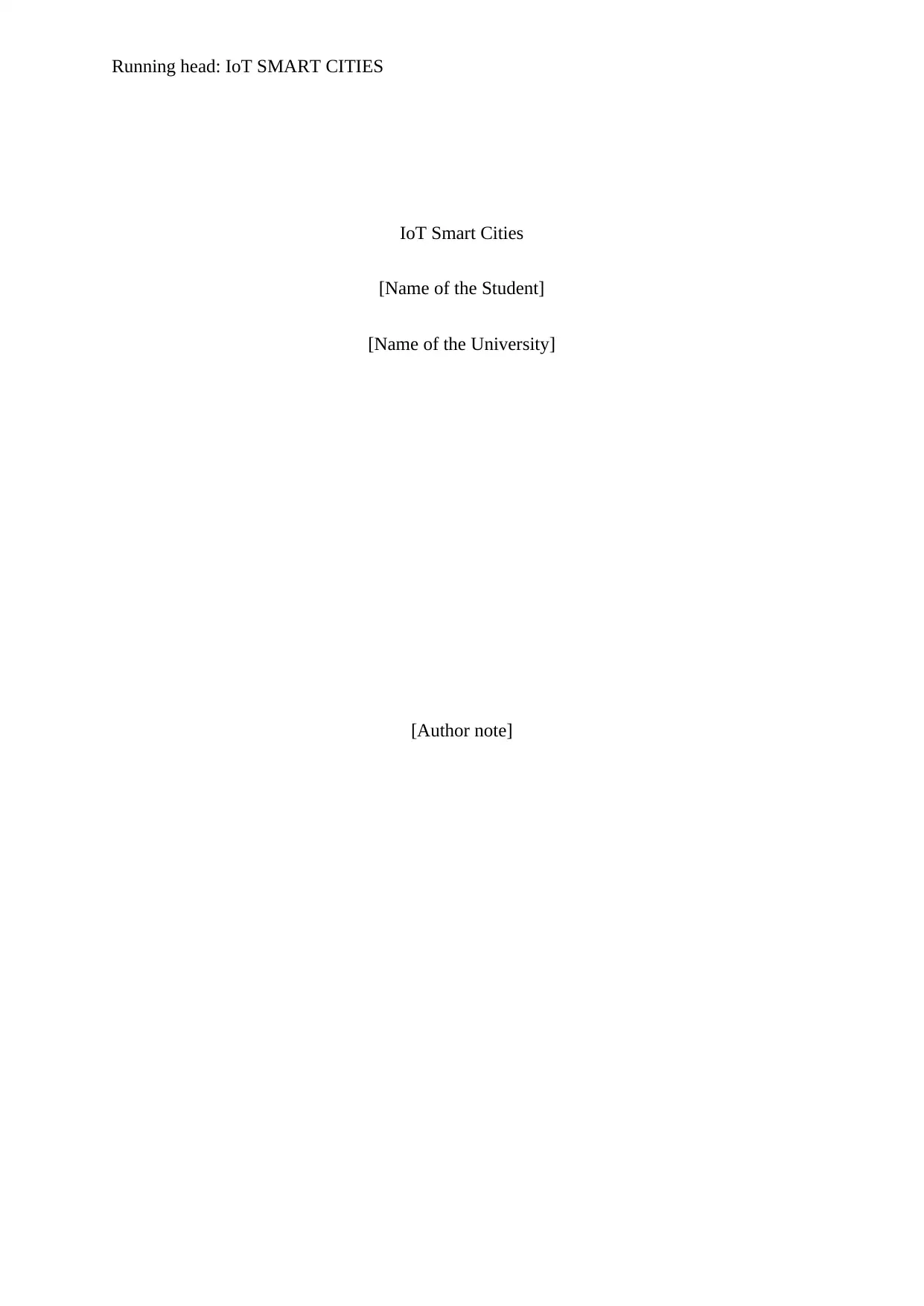
Running head: IoT SMART CITIES
IoT Smart Cities
[Name of the Student]
[Name of the University]
[Author note]
IoT Smart Cities
[Name of the Student]
[Name of the University]
[Author note]
Paraphrase This Document
Need a fresh take? Get an instant paraphrase of this document with our AI Paraphraser
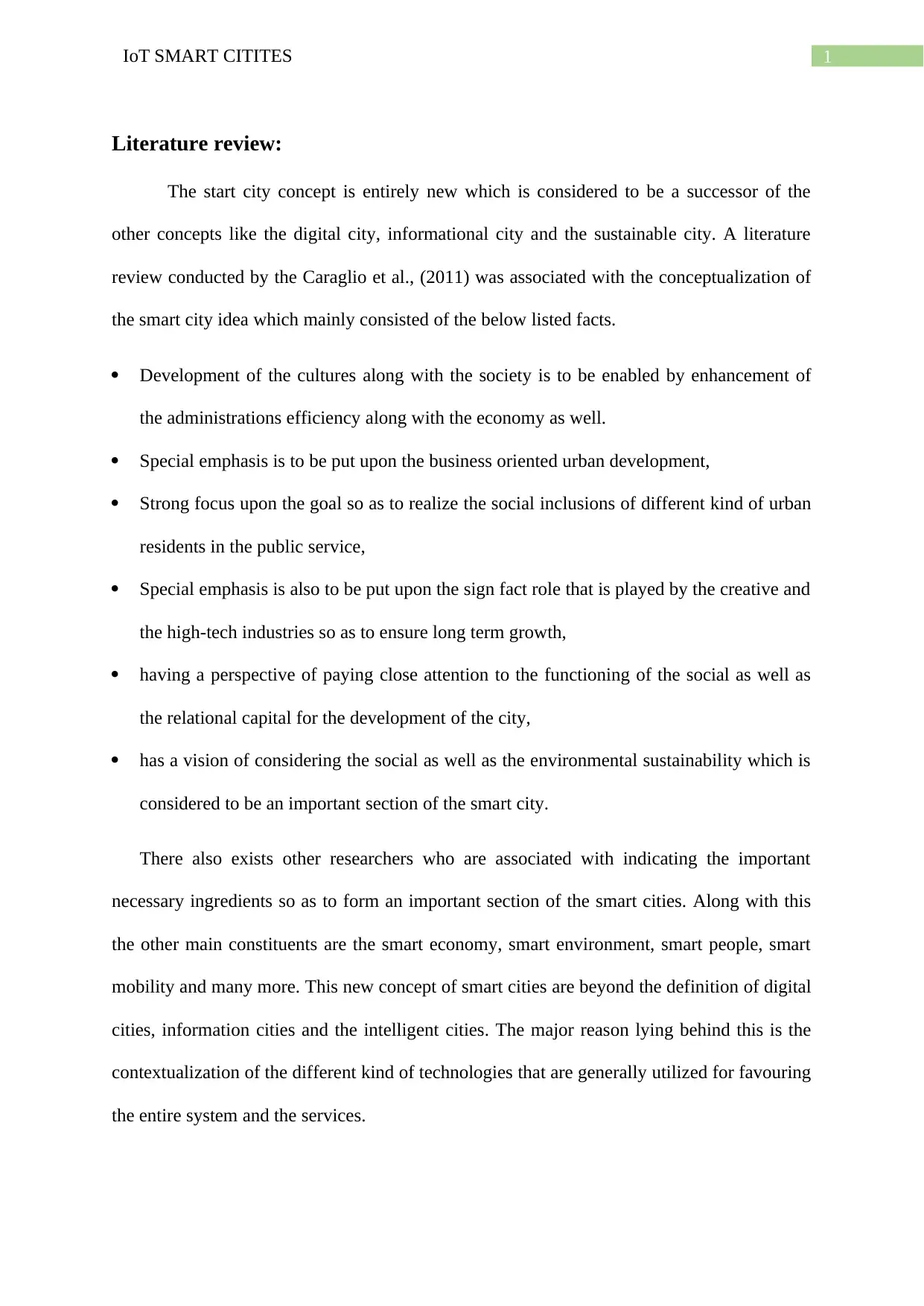
1IoT SMART CITITES
Literature review:
The start city concept is entirely new which is considered to be a successor of the
other concepts like the digital city, informational city and the sustainable city. A literature
review conducted by the Caraglio et al., (2011) was associated with the conceptualization of
the smart city idea which mainly consisted of the below listed facts.
Development of the cultures along with the society is to be enabled by enhancement of
the administrations efficiency along with the economy as well.
Special emphasis is to be put upon the business oriented urban development,
Strong focus upon the goal so as to realize the social inclusions of different kind of urban
residents in the public service,
Special emphasis is also to be put upon the sign fact role that is played by the creative and
the high-tech industries so as to ensure long term growth,
having a perspective of paying close attention to the functioning of the social as well as
the relational capital for the development of the city,
has a vision of considering the social as well as the environmental sustainability which is
considered to be an important section of the smart city.
There also exists other researchers who are associated with indicating the important
necessary ingredients so as to form an important section of the smart cities. Along with this
the other main constituents are the smart economy, smart environment, smart people, smart
mobility and many more. This new concept of smart cities are beyond the definition of digital
cities, information cities and the intelligent cities. The major reason lying behind this is the
contextualization of the different kind of technologies that are generally utilized for favouring
the entire system and the services.
Literature review:
The start city concept is entirely new which is considered to be a successor of the
other concepts like the digital city, informational city and the sustainable city. A literature
review conducted by the Caraglio et al., (2011) was associated with the conceptualization of
the smart city idea which mainly consisted of the below listed facts.
Development of the cultures along with the society is to be enabled by enhancement of
the administrations efficiency along with the economy as well.
Special emphasis is to be put upon the business oriented urban development,
Strong focus upon the goal so as to realize the social inclusions of different kind of urban
residents in the public service,
Special emphasis is also to be put upon the sign fact role that is played by the creative and
the high-tech industries so as to ensure long term growth,
having a perspective of paying close attention to the functioning of the social as well as
the relational capital for the development of the city,
has a vision of considering the social as well as the environmental sustainability which is
considered to be an important section of the smart city.
There also exists other researchers who are associated with indicating the important
necessary ingredients so as to form an important section of the smart cities. Along with this
the other main constituents are the smart economy, smart environment, smart people, smart
mobility and many more. This new concept of smart cities are beyond the definition of digital
cities, information cities and the intelligent cities. The major reason lying behind this is the
contextualization of the different kind of technologies that are generally utilized for favouring
the entire system and the services.
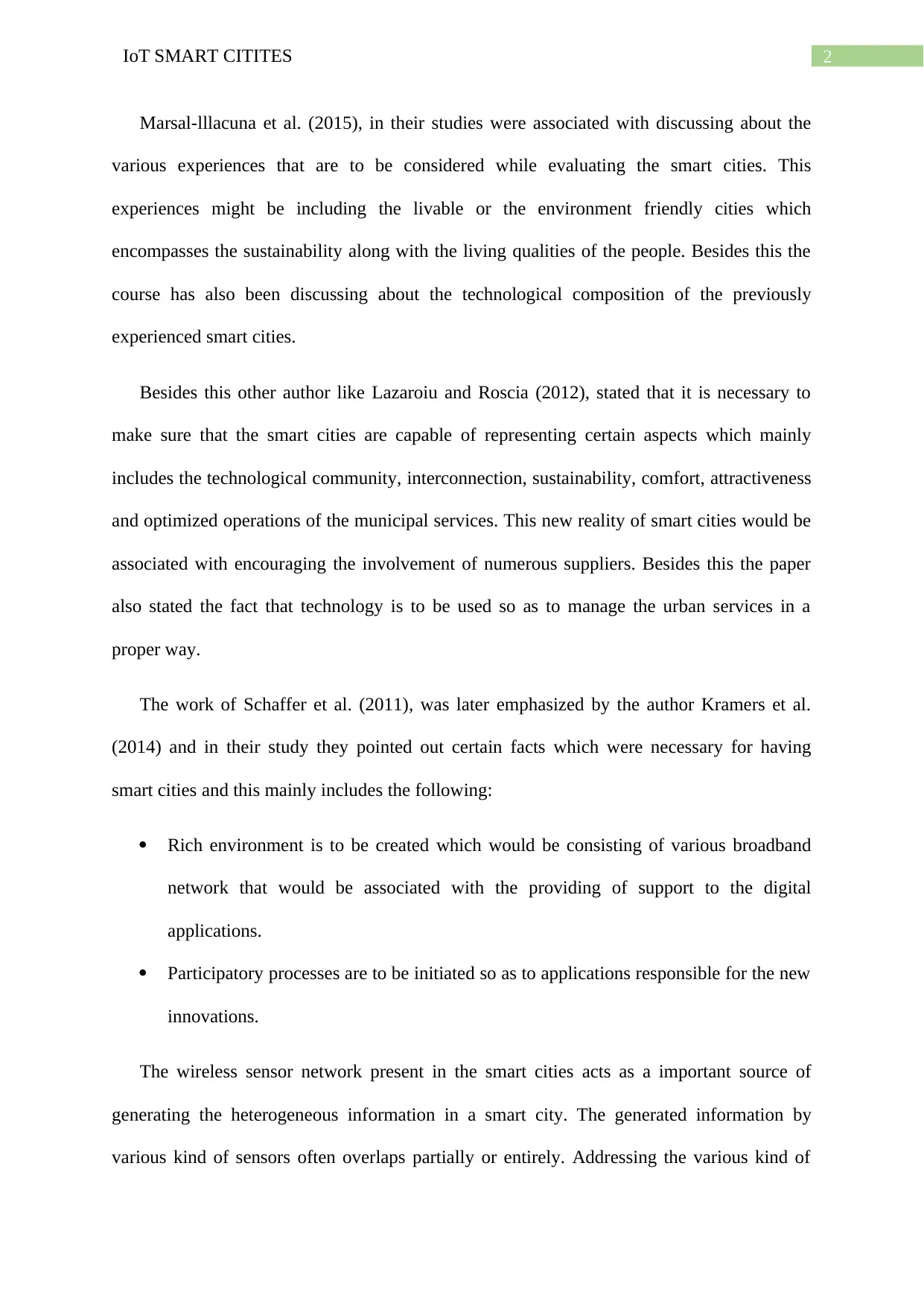
2IoT SMART CITITES
Marsal-lllacuna et al. (2015), in their studies were associated with discussing about the
various experiences that are to be considered while evaluating the smart cities. This
experiences might be including the livable or the environment friendly cities which
encompasses the sustainability along with the living qualities of the people. Besides this the
course has also been discussing about the technological composition of the previously
experienced smart cities.
Besides this other author like Lazaroiu and Roscia (2012), stated that it is necessary to
make sure that the smart cities are capable of representing certain aspects which mainly
includes the technological community, interconnection, sustainability, comfort, attractiveness
and optimized operations of the municipal services. This new reality of smart cities would be
associated with encouraging the involvement of numerous suppliers. Besides this the paper
also stated the fact that technology is to be used so as to manage the urban services in a
proper way.
The work of Schaffer et al. (2011), was later emphasized by the author Kramers et al.
(2014) and in their study they pointed out certain facts which were necessary for having
smart cities and this mainly includes the following:
Rich environment is to be created which would be consisting of various broadband
network that would be associated with the providing of support to the digital
applications.
Participatory processes are to be initiated so as to applications responsible for the new
innovations.
The wireless sensor network present in the smart cities acts as a important source of
generating the heterogeneous information in a smart city. The generated information by
various kind of sensors often overlaps partially or entirely. Addressing the various kind of
Marsal-lllacuna et al. (2015), in their studies were associated with discussing about the
various experiences that are to be considered while evaluating the smart cities. This
experiences might be including the livable or the environment friendly cities which
encompasses the sustainability along with the living qualities of the people. Besides this the
course has also been discussing about the technological composition of the previously
experienced smart cities.
Besides this other author like Lazaroiu and Roscia (2012), stated that it is necessary to
make sure that the smart cities are capable of representing certain aspects which mainly
includes the technological community, interconnection, sustainability, comfort, attractiveness
and optimized operations of the municipal services. This new reality of smart cities would be
associated with encouraging the involvement of numerous suppliers. Besides this the paper
also stated the fact that technology is to be used so as to manage the urban services in a
proper way.
The work of Schaffer et al. (2011), was later emphasized by the author Kramers et al.
(2014) and in their study they pointed out certain facts which were necessary for having
smart cities and this mainly includes the following:
Rich environment is to be created which would be consisting of various broadband
network that would be associated with the providing of support to the digital
applications.
Participatory processes are to be initiated so as to applications responsible for the new
innovations.
The wireless sensor network present in the smart cities acts as a important source of
generating the heterogeneous information in a smart city. The generated information by
various kind of sensors often overlaps partially or entirely. Addressing the various kind of
⊘ This is a preview!⊘
Do you want full access?
Subscribe today to unlock all pages.

Trusted by 1+ million students worldwide
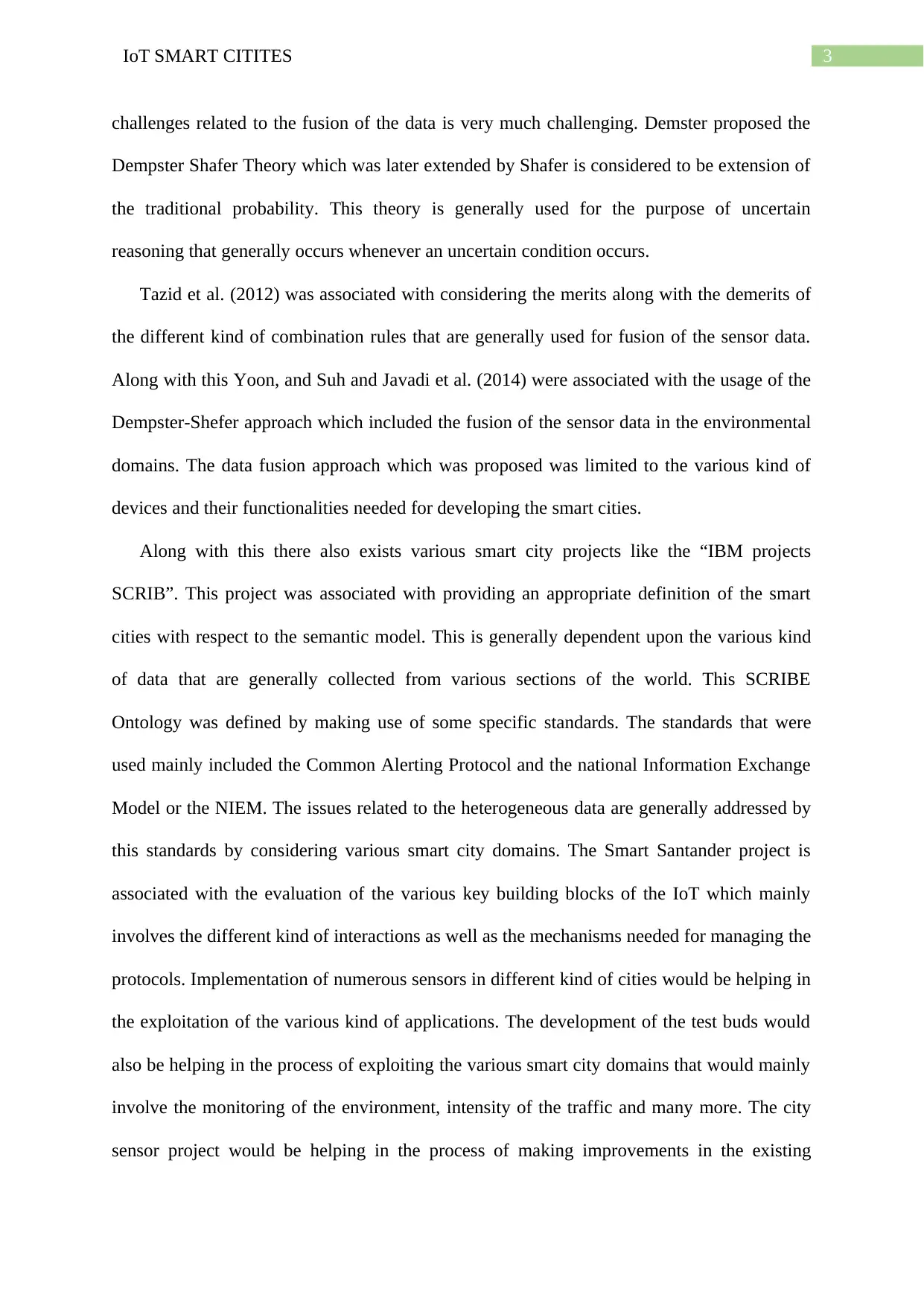
3IoT SMART CITITES
challenges related to the fusion of the data is very much challenging. Demster proposed the
Dempster Shafer Theory which was later extended by Shafer is considered to be extension of
the traditional probability. This theory is generally used for the purpose of uncertain
reasoning that generally occurs whenever an uncertain condition occurs.
Tazid et al. (2012) was associated with considering the merits along with the demerits of
the different kind of combination rules that are generally used for fusion of the sensor data.
Along with this Yoon, and Suh and Javadi et al. (2014) were associated with the usage of the
Dempster-Shefer approach which included the fusion of the sensor data in the environmental
domains. The data fusion approach which was proposed was limited to the various kind of
devices and their functionalities needed for developing the smart cities.
Along with this there also exists various smart city projects like the “IBM projects
SCRIB”. This project was associated with providing an appropriate definition of the smart
cities with respect to the semantic model. This is generally dependent upon the various kind
of data that are generally collected from various sections of the world. This SCRIBE
Ontology was defined by making use of some specific standards. The standards that were
used mainly included the Common Alerting Protocol and the national Information Exchange
Model or the NIEM. The issues related to the heterogeneous data are generally addressed by
this standards by considering various smart city domains. The Smart Santander project is
associated with the evaluation of the various key building blocks of the IoT which mainly
involves the different kind of interactions as well as the mechanisms needed for managing the
protocols. Implementation of numerous sensors in different kind of cities would be helping in
the exploitation of the various kind of applications. The development of the test buds would
also be helping in the process of exploiting the various smart city domains that would mainly
involve the monitoring of the environment, intensity of the traffic and many more. The city
sensor project would be helping in the process of making improvements in the existing
challenges related to the fusion of the data is very much challenging. Demster proposed the
Dempster Shafer Theory which was later extended by Shafer is considered to be extension of
the traditional probability. This theory is generally used for the purpose of uncertain
reasoning that generally occurs whenever an uncertain condition occurs.
Tazid et al. (2012) was associated with considering the merits along with the demerits of
the different kind of combination rules that are generally used for fusion of the sensor data.
Along with this Yoon, and Suh and Javadi et al. (2014) were associated with the usage of the
Dempster-Shefer approach which included the fusion of the sensor data in the environmental
domains. The data fusion approach which was proposed was limited to the various kind of
devices and their functionalities needed for developing the smart cities.
Along with this there also exists various smart city projects like the “IBM projects
SCRIB”. This project was associated with providing an appropriate definition of the smart
cities with respect to the semantic model. This is generally dependent upon the various kind
of data that are generally collected from various sections of the world. This SCRIBE
Ontology was defined by making use of some specific standards. The standards that were
used mainly included the Common Alerting Protocol and the national Information Exchange
Model or the NIEM. The issues related to the heterogeneous data are generally addressed by
this standards by considering various smart city domains. The Smart Santander project is
associated with the evaluation of the various key building blocks of the IoT which mainly
involves the different kind of interactions as well as the mechanisms needed for managing the
protocols. Implementation of numerous sensors in different kind of cities would be helping in
the exploitation of the various kind of applications. The development of the test buds would
also be helping in the process of exploiting the various smart city domains that would mainly
involve the monitoring of the environment, intensity of the traffic and many more. The city
sensor project would be helping in the process of making improvements in the existing
Paraphrase This Document
Need a fresh take? Get an instant paraphrase of this document with our AI Paraphraser
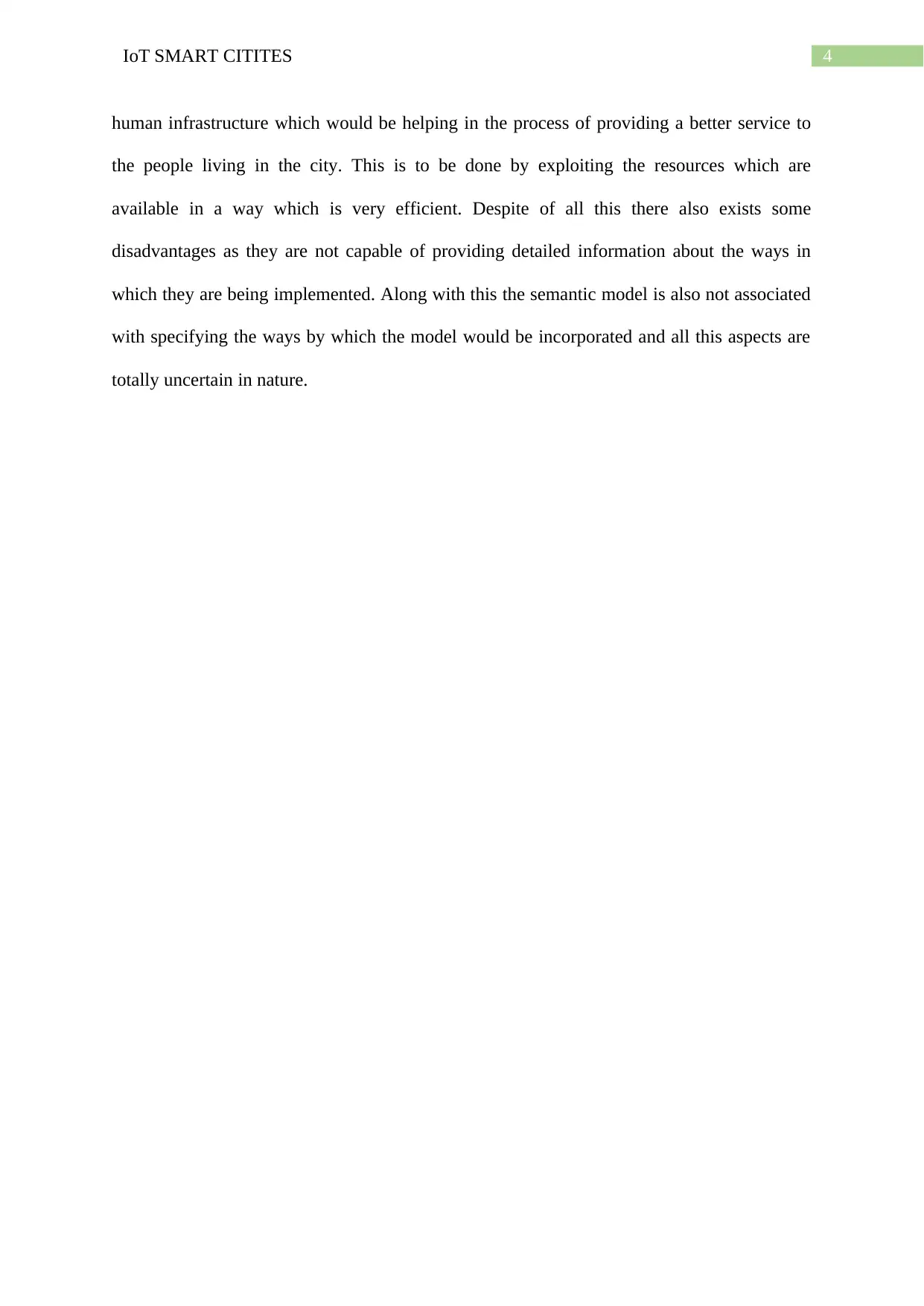
4IoT SMART CITITES
human infrastructure which would be helping in the process of providing a better service to
the people living in the city. This is to be done by exploiting the resources which are
available in a way which is very efficient. Despite of all this there also exists some
disadvantages as they are not capable of providing detailed information about the ways in
which they are being implemented. Along with this the semantic model is also not associated
with specifying the ways by which the model would be incorporated and all this aspects are
totally uncertain in nature.
human infrastructure which would be helping in the process of providing a better service to
the people living in the city. This is to be done by exploiting the resources which are
available in a way which is very efficient. Despite of all this there also exists some
disadvantages as they are not capable of providing detailed information about the ways in
which they are being implemented. Along with this the semantic model is also not associated
with specifying the ways by which the model would be incorporated and all this aspects are
totally uncertain in nature.
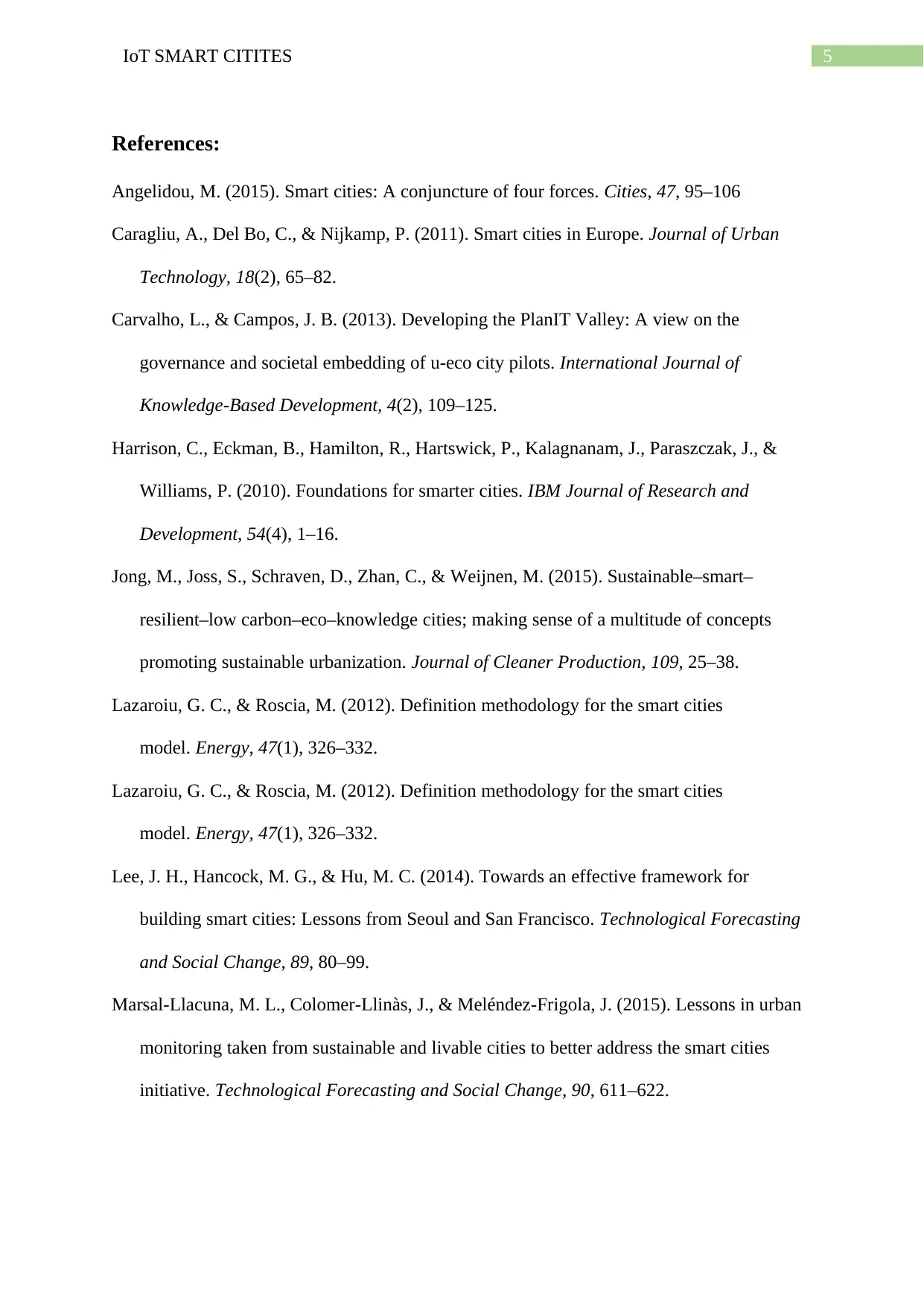
5IoT SMART CITITES
References:
Angelidou, M. (2015). Smart cities: A conjuncture of four forces. Cities, 47, 95–106
Caragliu, A., Del Bo, C., & Nijkamp, P. (2011). Smart cities in Europe. Journal of Urban
Technology, 18(2), 65–82.
Carvalho, L., & Campos, J. B. (2013). Developing the PlanIT Valley: A view on the
governance and societal embedding of u-eco city pilots. International Journal of
Knowledge-Based Development, 4(2), 109–125.
Harrison, C., Eckman, B., Hamilton, R., Hartswick, P., Kalagnanam, J., Paraszczak, J., &
Williams, P. (2010). Foundations for smarter cities. IBM Journal of Research and
Development, 54(4), 1–16.
Jong, M., Joss, S., Schraven, D., Zhan, C., & Weijnen, M. (2015). Sustainable–smart–
resilient–low carbon–eco–knowledge cities; making sense of a multitude of concepts
promoting sustainable urbanization. Journal of Cleaner Production, 109, 25–38.
Lazaroiu, G. C., & Roscia, M. (2012). Definition methodology for the smart cities
model. Energy, 47(1), 326–332.
Lazaroiu, G. C., & Roscia, M. (2012). Definition methodology for the smart cities
model. Energy, 47(1), 326–332.
Lee, J. H., Hancock, M. G., & Hu, M. C. (2014). Towards an effective framework for
building smart cities: Lessons from Seoul and San Francisco. Technological Forecasting
and Social Change, 89, 80–99.
Marsal-Llacuna, M. L., Colomer-Llinàs, J., & Meléndez-Frigola, J. (2015). Lessons in urban
monitoring taken from sustainable and livable cities to better address the smart cities
initiative. Technological Forecasting and Social Change, 90, 611–622.
References:
Angelidou, M. (2015). Smart cities: A conjuncture of four forces. Cities, 47, 95–106
Caragliu, A., Del Bo, C., & Nijkamp, P. (2011). Smart cities in Europe. Journal of Urban
Technology, 18(2), 65–82.
Carvalho, L., & Campos, J. B. (2013). Developing the PlanIT Valley: A view on the
governance and societal embedding of u-eco city pilots. International Journal of
Knowledge-Based Development, 4(2), 109–125.
Harrison, C., Eckman, B., Hamilton, R., Hartswick, P., Kalagnanam, J., Paraszczak, J., &
Williams, P. (2010). Foundations for smarter cities. IBM Journal of Research and
Development, 54(4), 1–16.
Jong, M., Joss, S., Schraven, D., Zhan, C., & Weijnen, M. (2015). Sustainable–smart–
resilient–low carbon–eco–knowledge cities; making sense of a multitude of concepts
promoting sustainable urbanization. Journal of Cleaner Production, 109, 25–38.
Lazaroiu, G. C., & Roscia, M. (2012). Definition methodology for the smart cities
model. Energy, 47(1), 326–332.
Lazaroiu, G. C., & Roscia, M. (2012). Definition methodology for the smart cities
model. Energy, 47(1), 326–332.
Lee, J. H., Hancock, M. G., & Hu, M. C. (2014). Towards an effective framework for
building smart cities: Lessons from Seoul and San Francisco. Technological Forecasting
and Social Change, 89, 80–99.
Marsal-Llacuna, M. L., Colomer-Llinàs, J., & Meléndez-Frigola, J. (2015). Lessons in urban
monitoring taken from sustainable and livable cities to better address the smart cities
initiative. Technological Forecasting and Social Change, 90, 611–622.
⊘ This is a preview!⊘
Do you want full access?
Subscribe today to unlock all pages.

Trusted by 1+ million students worldwide

6IoT SMART CITITES
Schaffers, H., Komninos, N., Pallot, M., Trousse, B., Nilsson, M., & Oliveira, A. (2011).
Smart cities and the future internet: Towards cooperation frameworks for open
innovation. In The future internet assembly (pp. 431–446). Berlin: Springer.
Schaffers, H., Komninos, N., Pallot, M., Trousse, B., Nilsson, M., & Oliveira, A. (2011).
Smart cities and the future internet: Towards cooperation frameworks for open
innovation. In The future internet assembly (pp. 431–446). Berlin: Springer.
Paraphrase This Document
Need a fresh take? Get an instant paraphrase of this document with our AI Paraphraser

7IoT SMART CITITES
References:
References:
1 out of 8
Related Documents
Your All-in-One AI-Powered Toolkit for Academic Success.
+13062052269
info@desklib.com
Available 24*7 on WhatsApp / Email
![[object Object]](/_next/static/media/star-bottom.7253800d.svg)
Unlock your academic potential
Copyright © 2020–2025 A2Z Services. All Rights Reserved. Developed and managed by ZUCOL.



